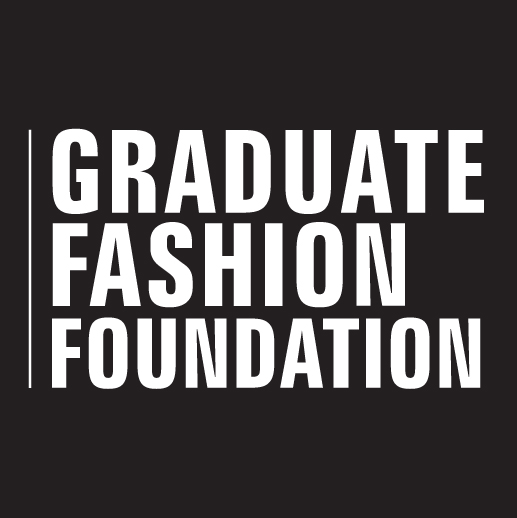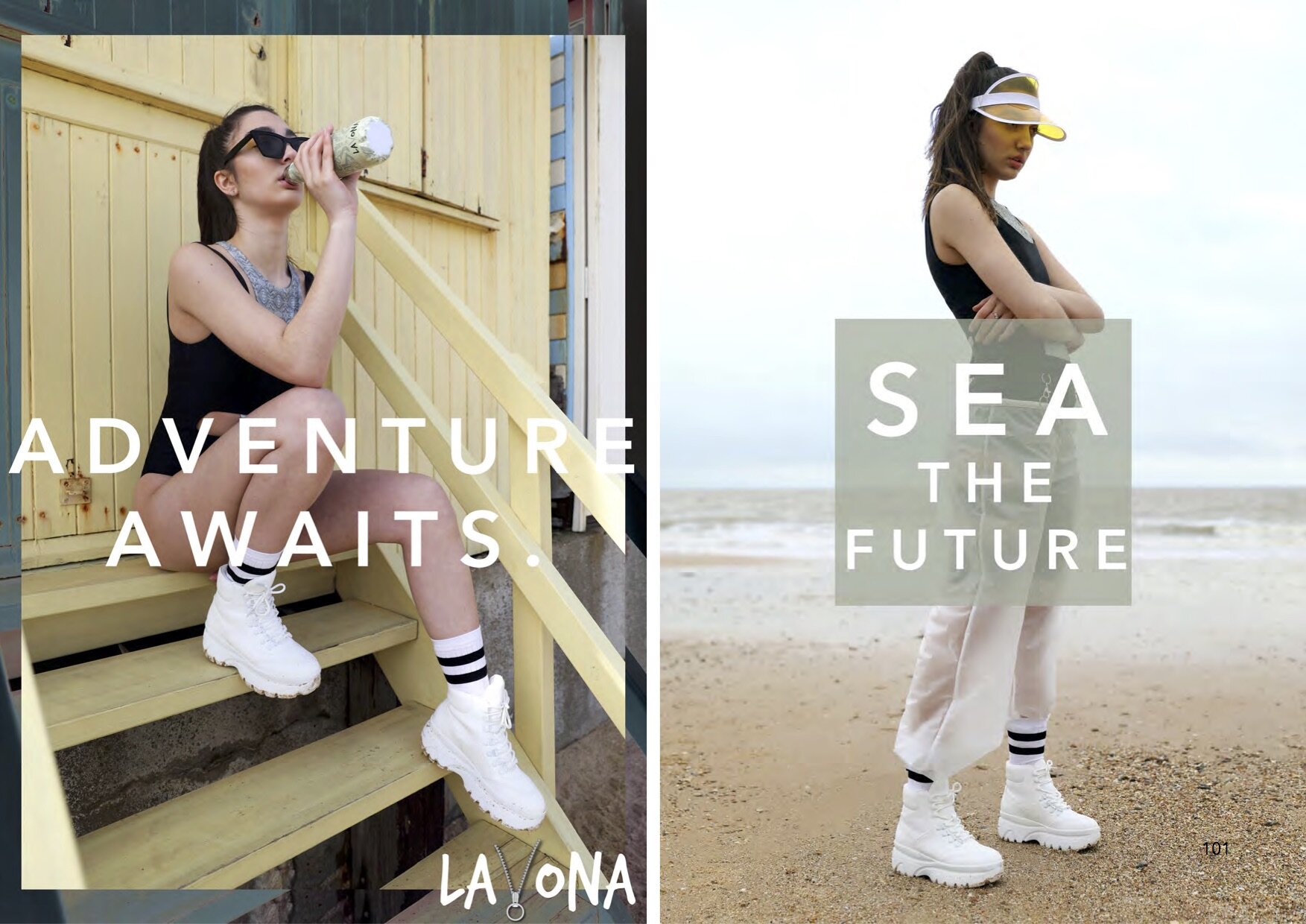Entrants into the Fashion Communication Digital Portfolio award have been tasked with submitting a well-executed, stylish, and professionally presented digital fashion portfolio that demonstrates individual creative identity, whilst communicating thinking process and development from the concept to final ideas. Meet the nominees below!
Abigail Parslow, University of Westminster
Growing up on the Isle of Wight, it was important to me to incorporate it within my nal campaign, hence I focused on the Isle of Wight brand Rapanui. After extensive research into the swimwear market and the polluting nature of the majority of swimwear options, I based my campaign on a hemp-based swimwear alternative as an extension for Rapanui. The extension line’s name RUKU stems from the Rapa Nui language, with RUKU meaning “to dive into water”, representing the brand values both literally and metaphorically.
Amy Foster, Norwich University of the Arts
Driven by my artistic background, my practice began with a fascination of studying facial features and drawing portraits; ultimately, transpiring into the compassionate approach recognised in my portraiture. The appeal is to curate beautiful, striking imagery that are abundant in detail, emotion, and intrigue, expressing personality and distinctive characteristics. Like a painting, the creative process behind an image is just as rewarding as the final outcome, from concept to composition, I aim to establish a compelling visual language to express an essence of my personality and sensitivity within my work to demonstrate my personal involvement throughout.
With keen interests in fashion, nature and people, my practice has evolved to enable my photography to be informed by my curious eye for conflicting colour, pattern, and texture. From the veins in a leaf to the pleats in a skirt, to the colours in an iris, my imaginative visions are inspired by all manner of daily obscurities that offer photographic potential. In my current work, I have focused my attentions on honesty and natural beauty within today’s filter- cultured society; making a conscious effort to ensure my models are unretouched and that all outfits and accessories are not purchased shoot-specifically. My ambition with my work is to unveil this artistic perspective, to demonstrate that fashion photography can be as conscientiously beautiful as it is statement-making by promoting positive, impactful change driven by honesty in an era where transparency is in demand.
April Howie, University of Central Lancashire
Due to COVID-19 I wasn’t able to produce my front and back cover onto beautifully printed paper or have it laser cut. The initial paper used was from GF Smith and was a very vibrant colour with tiny flecks of sparkles embedded within. I have tried to translate this as best as I could through a digital submission having to tweak the colours slightly. Please see images of the draft portfolio made with the beautiful papers. I would have also had pull outs for example on the website and social media as well as other 3d promotional pieces for postcards and my trend book etc. I apologise for the quality of these images they were taken at home.
Daniel Robinson, University for the Creative Arts Rochester
Taking poems as a guideline, I devised a series of editorials each aimed at a specific fashion magazine. Further visual research found in publications, such as Foam magazine’s fashion edition, provided inspirations for the art direction and photographic styles of my shoots. Collecting references from well-known and iconic photographers such as Deborah Turberville, Hassan Hajajj and David LaChapelle, I fused my own concepts with inspiration from their technical and creative practice to fully realise my outcomes.
What’s unique about this project is my analysis and skillset of critical and creative thinking influenced by my personal and intercultural experiences of identity, family life and living abroad, allowing my ideas to flourish into high quality outcomes through diligent efforts and well-informed research.
Ella Kenneally, Manchester Metropolitan University
W O M A N U P is a collection of 3 projects exploring women in male dominated spaces.
Within the first two projects I explore the world of women and male dominated sports, and aim to celebrate the sportswomen of the North and how these women are challenging gender roles and stereotypes and what it means to be a woman in the world of sport today. Only 4% of printed and digital sports coverage is dedicated to women’s sport. W O M A N U P is changing that statistic and is a new platform for Sportswomen in the North of England.
I am currently developing and expanding the brand of W O M A N U P from women in male dominated sports to encompassing women in other male dominated spaces. For vol.03, W O M A N U P is branching out into the world of Women and Male dominated Music and dissecting the way the industry views gender. W O M A N U P is a protest to the commonly thrown about phrases: “a girl can’t or shouldn’t do that” or “you’re not bad for a girl”. W O M A N U P is making a statement and we want to be heard, these women are marking their territory in the North of England.
Jessica Stone, University of Central Lancashire
As a workaholic generation we have forgotten what it is like to switch off from the noise, long working hours doesn’t always mean the greatest productivity. As we work from home and communal spaces we don’t have normal working hours and days. “The ideal work-to-break ratio was 52 minutes of work, followed by 17 minutes of rest” says Dr Travis Bamberry from Linkedin. The bottom line is that long hours and hard work are important, and even necessary, for entrepreneurs, but too much focus on hustling creates an unsustainable culture of panic and desperation. Hard work is admirable; for many, it’s required. But there’s more to life than the hustle. And it’s important to remember that it’s a means to an end, and not the end itself.
Imogen Thomas, Sheffield Hallam University
My final major project has been driven by my research into 21st-century consumer consumption habits and the artificial intelligence (AI) revolution. This coupled with my affinity for data-driven technology and sustainability led to a desire to create
Sum Space, a Community Interest Company that provides a hyper-local multifunctional concept space, for the benefit of the neighbourhood. The name of the space has been derived from the Gestalt theory: “The whole is greater than the sum of the parts.” This reflects Sum Space as the total sum of its community and forward-thinking philosophy. Each Sum Space would have an adaptation of the original brand identity, to stand independently but united as a group.
A marriage of art and technology, Sum Space is arranged over three levels: Studio, Cultural and Market Spaces within one footprint, for all to socialise, create, learn, and access curated products. The three spaces are fashioned by the clientele through the use of the Sum Space app. Local consumers input data they wish the space to access, allowing AI technology to decode user preferences.
Indigo Elsebach-Macey, University of Brighton
My final major project is titled ‘The Fragility of Human Existence’. During this project I have been working under an umbrella of topics within the title that I have researched and experimented with through the mediums of make-up artistry, photography and illustration. I decided on this area of study due to my Fascination with skin, working with the body and the frag-ile aspects of the human form; as well as the relationship to it’s environment both physical and social. The topic of fragile bodies and minds stems from my own personal relationship with the fragility of my body and mind. Being diagnosed with endometriosis and then fibromyalgia both ‘invisible illnesses’ that cause chronic pain, fatigue and many other life-altering symptoms connected me with the idea of using visual art to represent these, invisible yet very real feelings.
Lucy Randall, University of Hertfordshire
Lavona offers a fresh new approach to swim and athleisure wear that is versatile enough to mix and match as you desire. Selected pieces can interlink together to take the individual everyday garment into a fresh and exciting ensemble.
We create functional, comfortable yet modern and stylish clothing for the multi-facade woman. Our consumers want something different from outdoor wear, our clothes are made to look stylish when living life outside, inside, on land or in sea. Having swimwear be one of the main in uence for the brand, how we create swimwear and its impact on our environment is a strong value of ours. We are using recycled swimwear material for our swimwear collection because we have customers who care. Therefore we will use this as one of our marketing strategy in the campaign, to show- case that we are an environmentally conscious brand.
Olga Petrusewicz, Arts University Bournemouth
Exploration of childhood nostalgia and longing for simpler reality is encapsulated in the hunting ponies magazine. Merging the tactility of children’s publications with highly curated fashion stories, the publication invites the readers to express their inner child: explore, unfold and interact. Games, pull-outs and stickers ensure a deeply engaging and exciting experience, which is an escape from the stressful mindset and everyday struggles. Bold and bright colour palette focusing on warm reds, oranges and pinks is bringing youthful attitude and positivity throughout the pages.












